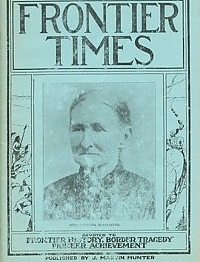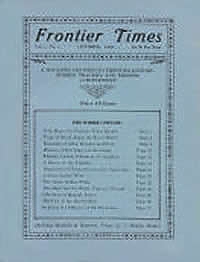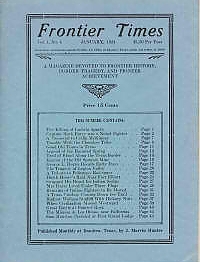By using our website, you agree to the use of cookies as described in our Cookie Policy
Magazines & Instant Downloads
Vol 10 No. 10 - July 1933
Mrs. Minerva Slaughter, Pioneer Mother (Cover image)
Very excellent story of venerable pioneer mother Mrs. Minerva Slaughter, who married Benjamin Slaughter February 11, 1834; came to Texas in 1839; lived in Caldwell county several years, then moved to Atascosa county in 1859; and to Frio county in 1874, where she resided until her death.
Further Mentions: Mrs. Walter Smith; her children were W. J. Slaughter of Frio Town, Texas; C. H. Slaughter of Carlsbad, New Mexico; Mrs. William Votaw of San Antonio; John H. Slaughter of Douglas, Arizona; and Mrs. W. N. Hiler, of San Angelo, Texas; She was buried in the old Frio Town cemetery; D. B. Little, W. A. Robert, J. N. Long, C. Woodward; Mr. Joe Loxton; Mrs. Milton Taylor.
Influence of McGuffey Readers on American Life
The profound and enduring moral, intellectual and emotional effects of this classic reader are here enumerated in detail.
Further Mentions: Frank P. Sibley; Charles E. Goodspeed; P. K. Foley; Andrew McCance, Henry H. Vail; Dr. David Swing of Chicago; Mark Sullivan; Dr. Hughes;
High Civilization in Panhandle 600 Years Ago
AN UNIDENTIFIED race, whose advent and departure are unknown, reached a high state of civilization in the Texas Panhandle 600 years ago. More than 100 ruins of houses, ranging in size from one room to 300 rooms, have been located and mapped by Floyd V. Studer, Amarillo business man and director of archaeology and paleontology and the Panhandle-Plains Historical Society Museum at Canyon. Most of them are found in the Panhandle.
ABOUT GERONIMO
Captain J. J. Deaver of Calallen, Texas, tells of the period of his life spent contemporaneous with the last capture of Geronimo, the Mescalero Apache chief. He was in the vicinity when Geronimo and His band were taken captive, but witnessed an interesting and little known battle that took place just prior to the capture of the chief. Mexican soldiers were also in pursuit of the Indians, so the two pursuing armies were unaware of the close proximity to each other. It was a dense wood-land where they ran into each other. So the United States Indian scout and the Mexican troops had a battle before the mistake was discovered. The scout said that an old Indian scout told him that if they had not stopped them they would have cleaned up the Mexican troops in short order.
Further Mentions: Col. George W. Baylor; White Mountain Apache Reservation; Frontier Battalion, Company "A", Texas Rangers; August Fransel; Captain J. B. Doak, formerly a captain in the' Confederate Army and later a resident of Coleman county, Texas; San Jose, Ojo Calientes Coralites, Janos, and Ofites to the Carrites Ranch on the crest of the Sierra Madres; Camp Rice; T. B. Templeton, now a resident at 1213 West St., Corpus Christi, a son-in-law of Capt. J. B. Doak; Pleas Russle, also a son-in-law of Capt. Doak; Joe Taylor, Tom Dockery, Dr. W. S. Bolton, Sam Doak, Butch Patterson ; Sam Cole, J. W. Clayton, Pink Peters, Sam Hillery; the massacre of Chief Victoria several years before below El Paso in the Candelera Mountains; Captain Crawford; Lieutenant Briton Davis; the Coralites Cattle and Mining Company; Capt. Slocum; the J. P. Nixon ranch in Medina county; the Salt Lick Pens on the River Hondo, which were made by John Redus and Tally Burnett in the early 60's
Rich Romance in the Life of a Cowboy
JAMES C. MITCHELL was a Texas cowboy, who for several seasons traveled with Buffalo Bill's Wild West Show. He died in San Antonio March 7, 1904, and the following account of romance in the life of this man appeared in the San Antonio Express, March 8, 1904:
"Jim Mitchell was noted for his remarkable mastery of horses. His performances in Europe with Buffalo Bill electrified ten thousand people at a time. He was noted as a peace officer, a man of heroic courage, good judgement, and one against whom there was never charged a malicious or evil thought. But there was more to Jim Mitchell than the public knew. There was a spiritual side and an emotional side of the man that gives the world a romance disclosed by his death and before which his brilliant deeds lose their luster. In the wall of a sitting room at his home, No. 1028 North Flores St. hung the portrait of a beautiful woman. This was the keynote of the ruling passion in Jim Mitchell's life. The picture was that of the late' Miss Florence Toole, the woman he won in a courtship in which he had for a rival Justin Huntley McCarthy, the brilliant English playwright, and the dramatist of "If I were King."
Further Mentions: Miss Florence Toole, daughter of John L. Toole, noted English actor; Colonel Cody; Justin Huntley McCarthy, son of the great historian;
The Pioneer Schools of Round Rock
By Mrs. Starkey Duncan. Account of Round Rock, Texas, a college town of great distinction. A curious rock formation rising abruptly from the bed of Brushy Creek gave the town its name. A beautiful grove of live oak trees suggested the title for the first college, Greenwood Masonic Institute. Texas was very young at the time that Round Rock's citizens felt the need of a first class institution of learning, and life was a little confused in the South. "It was directly after the war," says Mrs. Bella French Swisher, "the people, urged and assisted by Mr. G. C. Davis, built what is known as Greenwood Masonic Institute."
Further Mentions: Lake Creek; Robert Masterson, W. S. Peters, M. Wiess, H. B. Sh'eppard, Washington Anderson, George M. Dilley, J. L. Gray, E. P. Robinson, H. Koppel, W. D. Herrick. J. D. F. Williams, and J. M. Forwood; Robert Masterson, M. Wiess and W. S. Peters; Little River Presbytery of the Cumberland Presbyterian Church; A charter was obtained and was filed, April 11, 1881, by T. W. Royston, H. B. Sheppard, and H. A. Webb; Col. R. W. Pittman; J. M. Moore; JOHN L. LYLE; C. H. DOBBS; A. J. BROOKS; H. A. CHRISTIE; Prof. A. S. J. Steele; the Rev. Thomas J. Crosby; Mrs. Wesley Lyle of Beaumont; Clyde Wiess;
My Heritage
By G. A. L. in Georgetown Sun.
Account of the many bold, heroic and notable persons who constitute the great legacy and who formed the rich heritage of the State of Texas.
Further Mentions: old Frederick Ernest, who put up his books, closed the door to the little office in Germany and booked passage on a ship for Galveston ; worked his way inland through the wilderness with his small daughter and established a homestead, inducing friends from his homeland to do likewise until a colony of those hardy people had been formed along the lower reaches of the Colorado River. The diary and letters of his daughter plainly portray the struggles and heroism of this people, and the reader is proud to be called a German; the lives of LaFitte and LaSalle in whose veins coursed the blood of France's royalty; Lorenzo de Zavala; Baron de Bastrop and his little band of Prussian refugees; Issac Sanger, the wandering Jew; the flag of Gen. Sidney Sherman, the only banner carried by the victorious Texans in the Battle of San Jacinto; William E. Kendall of Houston, grandson of General Sherman; Mrs. Lucy Sherman Craig; Speaker Stevenson;
Five Years a Cavalryman
By H. H. McConnell. Ongoing, detailed and day-to-day journal recounting McConnell’s experiences are further related in this installment of his excellent story. To read this account is like being along for the ride. Frontier history comes alive in these pages, from the back of a great Calvaryman’s horse.
Further Mentions: Mr. Greeley; Sergeant, "Bully" Welch; Jim DeForrest, an Irishman, the other, Ahrberg, a German; the old Fourth Cavalry under Captain R. B. Marcy;
(Continued Next Month)
Why Worry - Asks William Jeffers Tomerlin, 107 Years Old
William Jeffers Tomerlin, Leakey, Real county, Texas, settler was born in Washington county, near Fayettville, Ark., March 28, 1826, His parents having immigrated from Ireland. Tomerlin eventually settled in the Frio Canyon. At the outbreak of the Civil War, Tomerlin joined forces with the Confederacy. The battle of Sabine Pass is recounted with precision, he being among the number which was called to the scene of the battle with General Magruder's forces, on the morning after the conflict.
Further Mentions: the little town of Millican; Dick Dowling; Commander Dowling's fort; Dr. Briton; General Magruder; H. H. Ochs, president of the Wolff & Marx Co;
FIRST REPORT CARD issued by the Bonham Public Schools
Mentions: Ray Peeler; the Peeler Drug Store in Bonham; Miss Etta Pullen was the teacher, and B. F. Pettus, the City Superintendent;
The Texas Ranger’s Place In Texas History
NOTE: Hunter’s Frontier Times are notable (among many other things) for their rich and detailed information regarding the rich legacy of the Texas Rangers. Here is one of the finest articles on the Rangers – rich in historical facts, details, developments. If you are interested in Ranger history, you must have this article in particular. The term "Texas Ranger" is vague when sought to be historically applied to the various volunteer and irregular organizations that have figured in the frontier service of Texas. The exact date of its original application is involved in doubt. During the period of American colonization under Austin and the Empressarios, there were provisions for a colonial militia, and volunteer companies of citizens were frequently raised to repel Indian attacks and to suppress domestic commotion. The latter were the first real Texas Rangers. This is the story of the origins and development of the Ranger’s great legacy in Texas.
Further Mentions: After the war of 1836, provision was made for maintaining mounted companies to defend the frontiers against Indians and these continued to per from distinguished service under the leadership of such chieftains as Burlesson, Highsmith, the McCulloughs. Coldwell, Ford, Ross; noted leaders, Walker, Hays and Gillespie; the lion hearted Richard Coke; McNally, Hall, Jones, Baylor, Oglesby, McKinney, Coldwell, McMurry, MoDonald, Shely, Nevil; Captain Robert Coleman; Henry Smith; Ben and Henry E. McCullough, John S. Ford, William P. Hardeman, William G. Cooke, Memucan Hunt, R. A. Gillespie, John McMullin; Tom Green; M. T. Johnson lieutenant colonel and James S. Gillett major; the Third Regiment of Rangers were Shapley P. Ross and Sam Highsmits; Lawrence Sullivan Ross; Cynthia Ann Parker, who, when a child, was stolen and carried away from Fort Parker, in Limestone County; A. P. Blocker and March Kennedy; Company A was organized May 25, 1874, with John Walker captain, J. W. Millican first lieutenant and J. T. Wilson second lieutenant. This company was disbanded April 30, 1875, with Lieutenant Wilson in command, but reorganized September 1, 1875, with Ira Long in command as first lieutenant, and upon his resignation J. M. Denton became, his successor. In December, 1876, Neal Coldwell became captain of the company, with J. B. Broadwell first lieutenant; In September, 1880, George W. Baylor of Company C was transferred to and made captain of Company A, and in 1884 L. S. Turnbo became first lieutenant; Company B was organized May 16, 1874, with G. W. Stevens as captain, S. J. Gorrah, first lieutenant, and Ira Long, second lieutenant. In June, 1878, June Peak was made captain. He was succeeded in April, 1880, by Ira Long, and he in turn by Bryan Marsh, in December the same year.. Marsh was followed by S. A. McMurry, September 11, 1881, and he after ten years of service as captain, resigned January 1, 1891, and was succeeded by W. J. MeDonald; Company C was organized May 20, 1874, with E. F. Ikard as captain, G. W. Campbell first and L. P. Beavert second Lieut. This company was reorganized in September, 1876, with John E. Sparks as captain, George W. Arrington first and John B. Tays second lieutenants. Soon after this Arrington was made captain, with George W. Baylor first and John B. Tays as second lieutenants. In September, 1882, various changes had occurred and John Hoffar had been placed in command of the company as first lieutenant, which position he held until he resigned from service in Nov., 1883. He was succeeded by George H. Schmidt as first lieutenant of Company D, Schmidt was promoted to captain May 1, 1884, and had A. C. Grimes as his first lieutenant. Company C was disbanded November 30, 1887; Company D was organized May 24, 1874 with C. R. Perry as captain and W. H. Ledbetter and D. W. Roberts, first and second lieutenants; with L. P. Seiker first and George H. Schmidt second lieutenants; Frank Jones; John R. Hughs; Company E was organized May 30 and June 6, 1874 with W. J. Maltby as captain, J. G. Connell, first and B. F. Best, second lieutenants, respectively. Best was soon promoted to first lieutenant with R. S. Foster, and later, N. O. Reynolds as second lieutenants. In September, 1879, C. L. Nevill became second lieutenant of this company, and one year later he was promoted to the captaincy. The company was mustered out of service in April, 1887, but reorganized in June 1891, with J. S. McNeil as captain. Ile was succeeded by Captain J. H. Rogers; Company F was organized June 4, 1874, with Neal Coldwell as captain and Pat Dolan and F. H. Nelson as first and second lieutenants. This company was reorganized in 1875, but retained Coldwell as captain and Dolan as first lieutenant. The next year Coldwell resigned 'and Dolan succeeded him, remaining in command until the Company was banded April 30, 1879; in July, 1874, that a. company of volunteer militia from Washington County was mustered in for active service in DeWitt and other counties in Southwest Texas, and later on the Rio Grande River. The company was commanded by Captain L. H. McNelly, with T. C. Robinson, first and J. W. Guyon, second lieutenants; a special company of Rangers was placed in the field by legislative authority in 1879, with J. Lee Hall as captain, and T. L. Oglesby, first lieutenant; Oglesby, S. A. McMurry.
The Rag-Picker's "Patchwork Palace."
By Henry W. Grady. R. MORTIMER Pitts was a ragpicker. Mr. Pitts had no home. With the restlessness of an Arab he flitted from one part of the city to another – this is the interesting and unusual story.
AN OLD CEMETERY
The oldest cemetery in Coleman county is located at Camp Colorado. It was established in 1857 on the left bank of Jim Ned Creek, 12 miles northeast of Coleman. Approximately one mile east of the camp site, a soldier's burial ground was located and members of that early frontier post were buried there. The earliest date decipherable on any tomb is 1860, but it is believed burials were made there in the late fifties. This is the brief story of that cemetery.
WOMAN WHO PIONEERED IN WEST TEXAS DIES
Account of Mrs. Araminta Holmsley, wife of one of the first settlers of Comanche County, Capt. James M. Holmsley, who went there in 1855 and was intimately connected with the thrilling events of early pioneering. Indian fighting, outlaw exterminating, cattle-train-driving frontier days, and who ruled the frontier activities with almost baronial power, while his bride was the power beside him to soften the impulses stirred up by exciting conditions. Mrs. Holmsley was born in Clifton, Mo., in 1847, in the old ox cart days before autos were even dreamed of. Her family soon after (migrated through the wilderness to Clifton, Texas, where the Captain wooed her and won her, and took her to the baronial castle in old-time Comanche which he had built for her, and where she lived and bore him children and where she died sixty or more years later in her bridal bed at Comanche.
Further Mentions: the cattle trails such as the ‘ol Chisholm; Fort Griffin, Dodge City, Hayes City, Ogallalla and the Black Hills; the obnoxious Davis State police
$4.95
‹ Back








